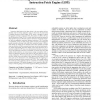282 search results - page 56 / 57 » On predicting secondary structure transition |
BMCBI
2004
13 years 7 months ago
2004
Background: In a previous paper, we introduced MUSCLE, a new program for creating multiple alignments of protein sequences, giving a brief summary of the algorithm and showing MUS...
BMCBI
2005
13 years 7 months ago
2005
Background: The sequencing of the human genome has enabled us to access a comprehensive list of genes (both experimental and predicted) for further analysis. While a majority of t...
LCTRTS
2009
Springer
14 years 2 months ago
2009
Springer
Instruction fetch behavior has been shown to be very regular and predictable, even for diverse application areas. In this work, we propose the Lookahead Instruction Fetch Engine (...
NIPS
2007
13 years 9 months ago
2007
Much of human knowledge is organized into sophisticated systems that are often called intuitive theories. We propose that intuitive theories are mentally represented in a logical ...
28
Voted
AI
2006
Springer
13 years 7 months ago
2006
Springer
In this paper we describe a machine learning approach for acquiring a model of a robot behaviour from raw sensor data. We are interested in automating the acquisition of behaviour...

